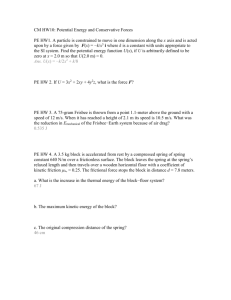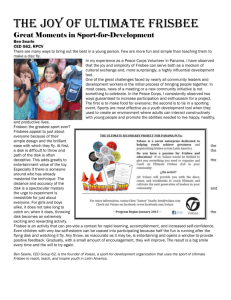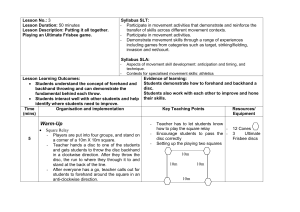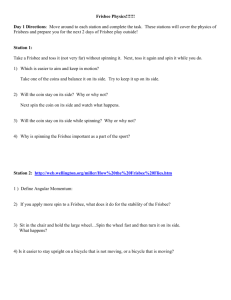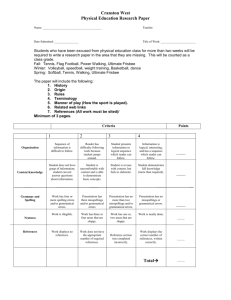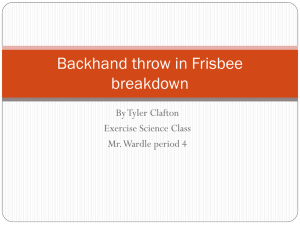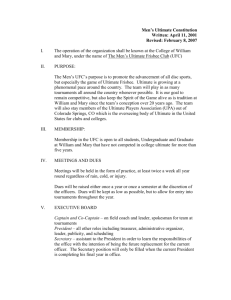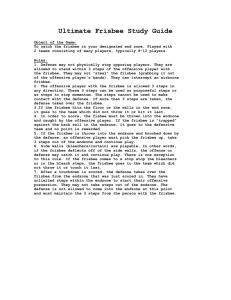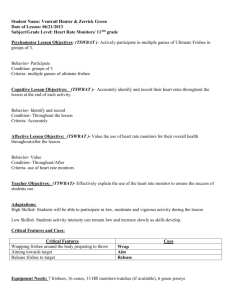Ultimate Frisbee Lesson Plan for High School PE
advertisement
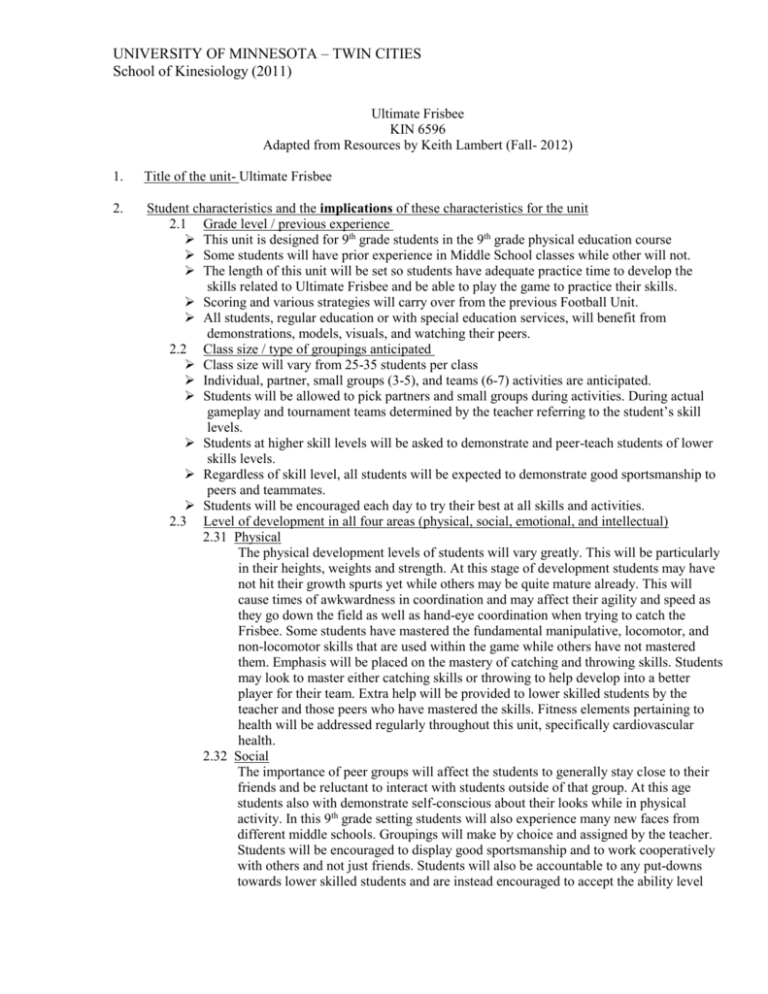
UNIVERSITY OF MINNESOTA – TWIN CITIES School of Kinesiology (2011) Ultimate Frisbee KIN 6596 Adapted from Resources by Keith Lambert (Fall- 2012) 1. Title of the unit- Ultimate Frisbee 2. Student characteristics and the implications of these characteristics for the unit 2.1 Grade level / previous experience This unit is designed for 9th grade students in the 9th grade physical education course Some students will have prior experience in Middle School classes while other will not. The length of this unit will be set so students have adequate practice time to develop the skills related to Ultimate Frisbee and be able to play the game to practice their skills. Scoring and various strategies will carry over from the previous Football Unit. All students, regular education or with special education services, will benefit from demonstrations, models, visuals, and watching their peers. 2.2 Class size / type of groupings anticipated Class size will vary from 25-35 students per class Individual, partner, small groups (3-5), and teams (6-7) activities are anticipated. Students will be allowed to pick partners and small groups during activities. During actual gameplay and tournament teams determined by the teacher referring to the student’s skill levels. Students at higher skill levels will be asked to demonstrate and peer-teach students of lower skills levels. Regardless of skill level, all students will be expected to demonstrate good sportsmanship to peers and teammates. Students will be encouraged each day to try their best at all skills and activities. 2.3 Level of development in all four areas (physical, social, emotional, and intellectual) 2.31 Physical The physical development levels of students will vary greatly. This will be particularly in their heights, weights and strength. At this stage of development students may have not hit their growth spurts yet while others may be quite mature already. This will cause times of awkwardness in coordination and may affect their agility and speed as they go down the field as well as hand-eye coordination when trying to catch the Frisbee. Some students have mastered the fundamental manipulative, locomotor, and non-locomotor skills that are used within the game while others have not mastered them. Emphasis will be placed on the mastery of catching and throwing skills. Students may look to master either catching skills or throwing to help develop into a better player for their team. Extra help will be provided to lower skilled students by the teacher and those peers who have mastered the skills. Fitness elements pertaining to health will be addressed regularly throughout this unit, specifically cardiovascular health. 2.32 Social The importance of peer groups will affect the students to generally stay close to their friends and be reluctant to interact with students outside of that group. At this age students also with demonstrate self-conscious about their looks while in physical activity. In this 9th grade setting students will also experience many new faces from different middle schools. Groupings will make by choice and assigned by the teacher. Students will be encouraged to display good sportsmanship and to work cooperatively with others and not just friends. Students will also be accountable to any put-downs towards lower skilled students and are instead encouraged to accept the ability level UNIVERSITY OF MINNESOTA – TWIN CITIES School of Kinesiology (2011) and be responsible to help them with skills they are struggling with. Focus will be on interacting with teammates to develop better skills and strategies for in game improvement. Competition will be added as motivation for some. 2.33 Emotional At this level students strive for acceptance and a place within peer groups. Often times students will suffer from low-esteem and behavior problems may arise due to low-selfesteem and the need for acceptance. Lack of participation could occur from students who are embarrassed at their skills and from boredom of those with higher skills levels. This could also result in behavioral problems from lack of motivation towards the activity. All students will be encouraged to do their best and to accept the ability levels of all other students. Students with higher skill levels might benefit from peer teaching those with lower ability levels. All students will be role models to one another in the classroom by making smart choices, keeping attitudes in the right place and by trying their hardest each day. Ways to students to become good role models is to honor out of bounds calls by players, recognizing a good play by either team, refraining from inappropriate language and movements, and helping/ encouraging classmates/teammates. Goal is to have everyone motivated to want to engage in unit. 2.34 Intellectual At this level students now have the capability concrete and abstract thinking processes. This includes but not limited to critical thinking, transfer of learning, high level problem solving and development of strategies. The focus will be for students to apply Ultimate Frisbee skills in developing specific strategies for the betterment of the team and as a player. Students will learn this through auditory, visual and kinesthetic learning techniques to increase the success rate of student learning and their abilities. Peers and directed teaching may be needed to help those students who are being challenge and not understanding skills and rules as well. Students with language challenges may need additional assistance when rules and strategies are being taught as well as on written tests. Visual aids and demonstrations will be critical to teaching specific rules, strategies, and skills. 3. Facilities and equipment 3.1 Space required [indoor / outdoor] Outdoor Soccer/Football Field with four Ultimate Frisbee fields (on occasion 8 fields) 3.2 Surface markings required Fields will be marked of by tall cones indicated out of bounds and two end zones Cones used to mark off certain activities 3.3 Equipment and supplies required 35 Frisbees 36 tall cones 48 small soccer cones 8 foam footballs 20 mesh pennies 14 hula hoops Poster size diagram of an Ultimate Frisbee Field Clipboard Whiteboard and markers Whistle Tournament Charts Handouts of skill diagrams and cues UNIVERSITY OF MINNESOTA – TWIN CITIES School of Kinesiology (2011) 4. Safety considerations & care of equipment Previous established class safety rules and courtesies applied Correct shoes while outside to prevent from slipping and turning ankles Be aware of students around keeping arms distance away while practicing skill drills Not throwing directly at person with strength when they are under 10 feet away No stepping on or throwing Frisbee into ground upon frustration Do not throw Frisbee away from field areas No climbing, pushing, hitting and grabbing students while attempting to guard or catch Frisbee No kicking or throwing cones Be aware of field out of bounds and running into other fields as well as the track around fields Retrieve errant Frisbees from other fields when play is not by errant Frisbee. Also make sure students are aware of your presence on field by calling it out. Keep Frisbees away from bleachers as well as any other equipment across the fields Stay off fields that are in play if done early with a game. 5. Subject matter content 5.1 Psychomotor skills in order of progression – Forehand Throw - Hold Frisbee with palm up. Make peace sign and hold Frisbee on rim with middle Finger. Index finger should be pointing towards middle of Frisbee - Bring elbow in of throwing arm with palm up and facing target - Step toward target with opposite foot, snap wrists and fingers as you release Frisbee - Keep palm up through entirety of skill Pancake Catch - Two-handed Catch - Have palms facing each other at right angles - Get body in front of Frisbee Rim Catch - One or two-handed catch - Used when Frisbee is above head or near ground - Catch by using hand(s) on leading edge of Frisbee Backhand Throw - Use dominant hand- place index finger along edge of Frisbee, thumb on top and other three fingers holding edge of Frisbee - Bring disc towards body by curling arm back- make sure to keep disc level - Extend Arm towards target, step with same foot as throwing with, and snap Wrist as you release Frisbee Throwing Power Agility footwork and quickness Throwing for Distance/Judgment of flight of Frisbee Group passing 3 on 3 game play Gameplay- teams of 6 vs. 6 (depending on size of class team sizes might vary) UNIVERSITY OF MINNESOTA – TWIN CITIES School of Kinesiology (2011) 5.2 5.3 Cognitive - knowledge, rules, strategy 5.21 Rules Field of Play- traditional field – 70 yards by 40 yards with 25 yard end zones Initiate Play- start in respective end zones- defense throws to offense Scoring – When team passes into end zone Movement of Disc- No running with disc must pass within 10 seconds Change of Possession- When pass not completed (out of bounds, drop, block or interception occurs) Non-contact- No physical contact between players Fouls- when a player initiates contact another player a foul occurs. When a foul disrupts possession, the play resumes as of the possession was retained. If player committing foul disagrees with foul call, play is redone Self-refereeing- Players are responsible for their own foul calls and line calls, players resolve their own disputes. Spirit of the game- Ultimate Frisbee stresses sportsmanship and fair play. Competitive play is encouraged but should adhere to rules, keep respect among all players and basic joy of play. 5.22 Ultimate Frisbee skills Cue words for catching and throwing skills Knowledge throwing power, judgment of flight, and passing skills Situations for use of correct runs, catches, and throws 5.23 Basic etiquette of Ultimate Frisbee Ability to come to fair compromise on disputes Honor fouls and line/out of bound calls from all players 5.24 Basic Ultimate Frisbee Strategy Use of quick short passes to effectively move disc down field Use of long throws only when needed and has can to be effective Using players in position suited for them- better throwers throw disc while better catchers make runs and catch disc Communicate with teammates Balance across the field- spread out players to keep from clustering 5.25 Skill related fitness concepts used in Ultimate Frisbee Agility Reaction time Endurance Anaerobic/Aerobic power Affective - attitudes, values, appreciation 5.31 Adherence to all class rules and directions 5.32 Proper use and handling of Frisbees and cones 5.33 Sportsmanship- being respectful of other students of all ability levels, demonstrate positive behavior when handling disputes and honoring calls 5.34 Positive attitude towards exercise by participating in class activities 5.35 Encouragement through working cooperatively with all students 5.36 Fun and enjoyment of physical activity 5.37 Respect safety of others by following rules and safety precautions 5.38 Value the game as an activity to engage in vigorous physical activity UNIVERSITY OF MINNESOTA – TWIN CITIES School of Kinesiology (2011) 6. Learning activities - teacher/student activities to be used in order to achieve the objectives - all activities should clearly reflect the requirements or purpose of the unit 6.1 Psychomotor - drills, lead-up games, stations, task cards, tournaments, etc. 6.11 Teacher and student demonstration of each skill taught 6.12 Partner throwing and catching drills to practice skills across from one another 6.13 Lead up activities to practice particular skills and strategies 6.131 Long distance throws two partners in cone boxes across field 6.132 Hula hoop target practice 6.133 Keep away within box with teams of three 6.14 Mini ultimate Frisbee game on smaller field with teams of three 6.15 Round robin tournament of smaller teams using Sport Education Model 6.2 Cognitive - explanations, visual aids, study sheets, tests 6.21 Skills taught individually, skills learned through explanation and broken down cues to each skill 6.22 Ultimate Frisbee handout that includes the rules, dimensions and cues to each skill 6.23 Testing through demonstration of skills- rubric attached at bottom 6.24 Teacher developed questions pertaining to Ultimate Frisbee (skills, rules & strategies) 6.25 Final test based on the rules, skills, and strategies of Ultimate Frisbee 6.3 Affective - activities, strategies for implementation 6.31 All students will all serve as Referees for their games 6.32 Students will be placed in teams of differing ability levels 6.33 Discussion to encompass all aspects of Ultimate Frisbee 6.34 Students will effectively use communication skills to solve disputes 6.1 Lickety-Split Frisbee Citation Frisbee® Games & Activities (2010) Retrieved July 30th, 2012, from http://www.nrgbalance.org/documents/Frisbee-Games-Activities.pdf Explanation: Students will find a partner and stand a determined distance apart such as 15 feet. Object is to throw discus back and forth and successfully catch Frisbee in 2 minutes. Team scores a point for every successful pass and catch. Diagram: Related Objective: Psychomotor- students will use proper form when using different throwing and catching skills Modifications: Catching disc under a leg, behind the head, or with one hand earns two points Shorter or longer rounds as well as shorter or longer distance between partners Safety: Make sure to stay two arm’s length away from other students on respective sides Keep throwing power down during short distances 6.2 Long Toss Relay Citation O’Neil, T. (March 2012). In conversation during student observation of Ultimate Frisbee unit at North St. Paul High School with high school physical education teacher. North St. Paul, MN. Explanation: Students will be placed groups of 6 and find one of the five fields for this activity. Fields will be set up in triangular fashion with triangles made out of cones at each point. Triangles will be set up 30 yards away from one another. One player will be each triangle From a team while the other three sit out. Groups switch players in triangles after a round. Object is to pass disc from each other in a clockwise fashion. Groups score for every Successful time the disc makes it back to the starter. If pass is dropped or goes out of UNIVERSITY OF MINNESOTA – TWIN CITIES School of Kinesiology (2011) triangle boundary, player closet grabs it and becomes the starter. Rounds will be 1 and a half minutes. Each group will combine their scores from each round. Diagram: Related Objective: Cognitive- students will use knowledge of throwing power and accuracy for the betterment of their throws Modifications: Have two players in each triangle. These two will be on opposite teams. Goal is starter to pass to teammate in other triangles successfully. Scoring- if successful pass is made. Safety: Adequate space must be provided between fields Proper safety techniques when playing modified game. 6.3 Distance Competition Citation Disc Skills, Games, and Activities- © Australian Flying Disc Association (2012) Retrieved July 30, 2012 from http://www.afda.com/resources/Disc+Skills,+Games+and+Activities.pdf Explanation: students will get into groups of 4 each having a disc. Cones will be set up as a throwing line. Students will go one at a time in their groups upon instruction. Farthest throw wins in the group. Students will be instructed when to retrieve discs. Diagram: Related Objective: Psychomotor- students will use proper form of throwing skills to achieve further throws Modifications: Only forehand or backhand throws Throws measured by where they land, not where they stop Place hoops in field to promote as targets Safety: Students adhere to rule that they only retrieve discs when teacher instructs 6.4 Double Box Citation Disc Skills, Games, and Activities- © Australian Flying Disc Association (2012) Retrieved July 30, 2012 from http://www.afda.com/resources/Disc+Skills,+Games+and+Activities.pdf Explanation: Same as Ultimate Frisbee but with teams of three. Fields will be the size 20 yards in width and 20 yards in length with two 5 yard end zones. Teams use same rules as ultimate apply. Score by catching disc in end zone. Pennies will be provided for half of students. Switch teams to different fields after 5 minutes of play. Diagram: Related Objective: Cognitive- knowledge of the strategy to use short quick passes to move disc successfully down field to score. Modifications: Larger or smaller fields Allow only one teammate into an end zone Use foam football instead of a Frisbee- used to help teach rules and strategies Safety: Adhere to all rules of Ultimate Frisbee Non-contact means no contact at all between players UNIVERSITY OF MINNESOTA – TWIN CITIES School of Kinesiology (2011) 6.5 Frisbee Tossback Citation Frisbee and Volleyball Activities (March 2009) Retrieved July 30, 2012 from http://www.peuniverse.com/Clipboards/ClipboardDetails/tabid/81 /IndexID/3874/Default.aspx Explanation: students will partner up with one other person. Students will line up across From each other to start. After each successful throw and catch made one student will move back one step. Goal is for student stepping back after each successful throw/catch to reach line marked off by cones. Diagram: Related Objective: Affective- teams will adhere to only one step back by not cheating by taking more than one step and only stepping when a successful throw/catch occurs. Modifications: Have students start at goal line and instead stepping back step forward for a successful throw/catch Make teams of three instead of two Safety: Allow 10 feet of distance between other students on different teams Call out errant Frisbees if they are going at someone who is unaware of it. 7. Unit calendar - block plan –Provided at bottom of unit plan 8. Lesson Plans- Developed from Unit Plan activities and objectives 9. Assessment and Evaluation - tools or procedures which will indicate when the behavior specified in the unit objective has been achieved 9.1 Psychomotor - skill tests, task completion, checklists, rubrics 9.11 Skill tests- during tournament time observe and if necessary take students aside to demonstrate ultimate Frisbee skills. Skills rubric on bottom of unit plan entails scoring within each skill. 9.12 Task completion- successfully score and participate in all activities and games. 9.13 Checklist- Individuals implement rules of the game. 9.2 Cognitive - written tests, strategy implementation, verbal response 9.21 Ultimate Frisbee Handout with worksheet 9.22 Final test of rules, skills and strategies 9.23 Verbal response to teacher when recalling elements of the game 9.3 Affective - cooperation, respect, etc. 9.31 Proper handling of all equipment especially Frisbees used 9.32 Positive attitudes for respect and cooperation with all other students. Lack of Participation and negative attitudes will effect participation grades. 9.33 Follow rules of all activities- cheaters will be marked 9.4 Overall grading scheme/weighting for the specific unit and how the unit fits into the overall quarter, trimester, etc. evaluation plan 9.41 Participation points- 10 points will be awarded each day of unit. Loss of points consists not dressing properly (2 points), cooperation and respect for students (2 points), adherence to rules of activities (2 points), and participation (4 points). 10x 10= 100 points total for unit 9.42 Skill assessments (use skill rubric) Forehand throw- 4 points possible UNIVERSITY OF MINNESOTA – TWIN CITIES School of Kinesiology (2011) Backhand throw- 4 points possible Pancake catch- 4 points possible Rim Catch- 4 points possible Demonstration of throwing power variations- 4 points possible 9.43 Cognitive assessments Ultimate Frisbee Worksheet- 5 points possible Final test- 10 points possible 9.44 Demonstration of proper knowledge of rules, skills, strategies while in various Tournaments- 25 points possible 9.45 Make-up points- Written summary of activity performed outside of class for each day of excused absences- maximum two days . Unexcused absences will follow School Policy Guidelines. Excused absences exceeding two days will be dealt with through Department Policy. Maximum of 20 points possible. 9.46 Summary of Point/Grading scale of 150 points 135 points and above = A 120 points and above = B 105 points and above = C 90 points and above = D 9.47 This is one of five units during the course of a trimester. Each unit carries a weight of 150 points. Another 100 points for a trimester are based on fitness elements. 10. 11. Motivation techniques - strategies used to promote enjoyment, success, and adherence 10.1 Intrinsic - success, challenge, self-confidence, etc. Activities will be set up to the favor of ability levels of the students. Activities will allow each student to enjoy them their way. Examples include allowing them to pick friends for a lot of the activities most likely placing them with someone of their skill levels and letting them go at the pace they choose while performing the activities. Students will also be encouraged to challenge themselves within the activities. 10.2 Extrinsic - competition, awards, unique drills / warm-ups, etc. Each activity is set up to challenge students with each other and against one another. Activities are set up to challenge students against each other either in teams or groups. Tournaments will be set up to provide competitive situations and allow them to utilize all of their skills. Awards will be provided to winners of tournaments and those how displayed sportsmanship by adhering to rules the greatest. Warm-ups and activities will be continuously be switched to enhance levels of participation. Relationship to Standard(s) at the appropriate level – either District or NASPE 11.1 NAPSE standards- All standards met throughout unit. Standard 1: Demonstrates competency in motor skills and movement patterns needed to perform a variety of physical activities Standard 2: Demonstrates understanding of movement concepts, principles, strategies, and tactics as they apply to the learning and performance of physical activity Standard 3: Participates regularly in physical activity Standard 4: Achieves and maintains a healthy enhancing level of physical fitness Standard 5: Exhibits responsible personal and social behavior that respects self and others in physical activity settings Standard 6: Values physical activity for health, enjoyment, challenge, self-expression, and/or social interaction 11.2 Explain the relationship of the unit plan to the standard(s) These standards were though of throughout the process of creating this Unit Plan. The goal of this unit was to reproduce effective use the developmental categories of psychomotor skills, cognitive skills, and affective skills. Through correct teaching and implementation of UNIVERSITY OF MINNESOTA – TWIN CITIES School of Kinesiology (2011) these categories as they relate to the game it allows all standard to be met by participation in the activities and games. The unit was designed so that students could demonstrate achieving these standards through adherence of the activities and participation. 12.References - minimum of four resources used in developing the unit with complete citation Frisbee® Games & Activities (2010) Retrieved July 30th, 2012, from http://www.nrgbalance.org/documents/Frisbee-Games-Activities.pdf O’Neil, T. (March 2012). In conversation during student observation of Ultimate Frisbee unit at North St. Paul High School with high school physical education teacher. North St. Paul, MN. Disc Skills, Games, and Activities- © Australian Flying Disc Association (2012) Retrieved July 30, 2012 from http://www.afda.com/resources/Disc+Skills,+Games+and+Activities.pdf Frisbee and Volleyball Activities (March 2009) Retrieved July 30, 2012 from http://www.peuniverse.com/Clipboards/ClipboardDetails/tabid/81 /IndexID/3874/Default.aspx National Association for Sport and Physical Education. (2004) Moving into the future: National standards for physical education (2nd ed.). Reston, VA: Author. High School PE lesson ideas- TGFU Grid Ultimate Frisbee (Winter 2006) Submitted by Duell, K. E., Retrieved July 30, 2012 from http://www.pecentral.org/lessonideas/ViewLesson.asp?ID=6802 Spletzer, E. (2009) Pickle-ball- A sample unit plan. Retrieved July 30, 2012 from https://moodle2.umn.edu/course/view.php?id=5172 Lund, J. L. & Kirk, M.F. (2010-2nd ed.). Performance assessment for middle and high school physical education. Champaign, IL: Human Kinetics. ISBN-13: 9780736083607 UNIVERSITY OF MINNESOTA – TWIN CITIES School of Kinesiology (2011) Keith Lambert Unit: Ultimate Frisbee block plan Day 1 Content P- practice of throwing and catching skills C- Basic cues words to skills A-Practicing skills at safe distance from others Objectives P- Gain a basic feel for throwing and catching skills C- Understand what cues words are for A-properly handle and throw Frisbee Activities -teacher demonstration of skills -Partner throwing and catching drills - Activity 6.1Lickety-Split Frisbee Day 2 Content P-practice throwing and catching skills, implement long distance throws. C- Gain a knowledge of throwing power in different throwing skills A-proper safety techniques when throwing around classmates Objectives P- develop throwing skills through implementation of longer throws C- understand when to use long throws A-demonstrate proper safety around students Activities -Partner throwing and catching -Long distance throws with partners across field in cone boxes -Activity 6.3Distance Competition University of Minnesota- Kinesiology Department Grade- 9th Summer 2012 Day 3 Content P- practice throwing and catching skills while working on agility and coordination through movement C- Gain knowledge about using long throws and how to aim A-understand sportsmanship between other students Objectives P- demonstrate ability to run and catch disc as well as throw from that spot C- understand use of long throws as well as demonstrate knowledge about accuracy/aiming. A-Use acceptable behavior while participating in activity Activities -Partner Catch -hula hoop target practice -Activity 6.2-Long Toss Relay Day 4 Content P- practice passing skills as a group C- gain knowledge about different strategies on an individual A-adhere to directions and rule of activity Objectives P-use throwing and catching skills as a group of students effectively C-demonstrate strategies to improve success of passes A-follow rules and directions by not cheating Activities -Three person catch -Keep awayteams of three -Activity 6.5Frisbee Tossback (modified version with three players) Day 5 Content P- practice all skills of Ultimate and gain feel for gameplay C- Learn rules of Ultimate Frisbee etiquette of the game A-adhere to rules and directions, use encouragement, and positive sportsmanship Objectives P-Demonstrate ability to play ultimate Frisbee as a team C-understand rules while in gameplay A-follows rules of the game. Demonstrates proper etiquette and sportsmanship Activities -Teacher demonstration of rules and strategies -Team Catch (6 players-split into 3’s after completed) -Activity 6.4Double Box -Ultimate Frisbee handout UNIVERSITY OF MINNESOTA – TWIN CITIES School of Kinesiology (2011) Day 6 Beginning of Class- review of handout Teacher instruction of ways to improve for students Content, objectives and Activities stay the same as Day 5 Added Activities -Double Box will be played in round robin tournament format with teams selected by teacher Day 7 Content P-use of throwing and catching skills in game C-use strategies in gameplay. Remembering rules and etiquette A-adhere to rules, respect safety of students, participate as an active member of your team Objectives P-use of skills to score within game C-implement strategies during gameplay and demonstrate etiquette A-follow rules of game, handle disputes positively, show active participation Activities -Team warm-up of skills -Ultimate Frisbee games on four fields Day 8 Content Same as Day 7 Objectives Same as Day 7 Activities -Team warmup of skills -Start of Ultimate Frisbee tournament of 8 teams as set up by teacher Day 9 Content Same as Day 7 &8 Objectives Same as Day 7 &8 Activities -Team warmup of skills -Continue tournament between teams Day 10 Content P-use of throwing and catching skills with proper cues C-recall all skill cues, rules and strategies in gameplay A-adhere to rules, respect safety of students, positive sportsmanship/cooperation, value game as a fun and as physical activity Objectives P-Demonstrate cues of all skills C-demonstrate rules and strategies as well as proper cues A-demonstrated proper adherence to sportsmanship, rules, and cooperation in gameplay. Activities -Final Test -Tournament play- final matches -As tournament is play- skill assessment of students -Closing discussion about Ultimate Frisbee UNIVERSITY OF MINNESOTA – TWIN CITIES School of Kinesiology (2011) Skills Rubric 4- Student performs skills with no or few observable errors in technique 3- Student performs skills with good technique and has most aspects of skills down. Student also shows ability to self-correct errors 2- Student performs some techniques of skills with many errors. Student needs assistance to help correct errors 1- Student performs skills ineffectively and unable to perform correctly. Student requires assistance from others to participate Table used to score skills example Student Keith Jim Forehand Throw 4 4 Backhand Throw 2 4 Pancake Catch Rim Catch 4 2 3 1
